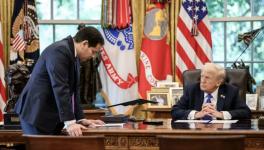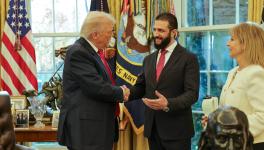Pax Americana and the Threat of Nuclear Armageddon
Teaser: The decade ends with the US leading the charge for a nuclear armageddon, dismantling all nuclear arms control treaties, and adopting a military doctrine of winnable nuclear wars. The Russian response has been asymmetric—developing new weapons as low costs—with the hope that the US would return to earth and negotiate. Unfortunately, the earth is still waiting.
The decade ends with two major threats to humanity: global warming leading to a climate catastroph and the threat of a nuclear war extinguishing our civilisation. The US has pulled out of the Paris Agreement, and is wrecker-in-chief of the weak climate change agreement that all the countries had signed to limit the emission of greenhouse gases. It is also leading the charge for a nuclear armageddon, dismantling all nuclear arms control treaties. Expectedly, there has been a Russian response, but not by matching the US efforts but by asymmetric measures designed to defeat the US attempts of gaining nuclear dominance. Such an asymmetric response does not reduce the threat of a nuclear exchange but only ensures that there will be no winner in such a nuclear war.
What are the threats that could cause a nuclear exchange between the US and Russia? There were three nuclear arms control treaties that were reached between the US and Russia in the 70’s-80’s, all of which were based on the understanding that nuclear war was not winnable; each side had enough weapons not only to destroy each other but also the entire globe. The three treaties are: the Anti Ballistic Missile (ABM) Treaty, the Intermediate-Range Nuclear Forces Treaty, and the last the Strategic Arms Limitation Treaty, which has now metamorphosed as the Strategic Arms Reduction Treaty (START).
All these treaties were based on what is called Mutually Assured Destruction (MAD) doctrine, that if each side had enough nuclear weapons to destroy the other after receiving a first strike, there would be a balance of terror and therefore less likelihood of a nuclear war. Two of this—ABM Treaty and the INF Treaty—have been formally abandoned by the US, while the fate of the third, START which expires in 2021, hangs in balance.
To add to nuclear dangers, India and Pakistan have stepped up the rhetoric of war, with India withdrawing from its position of a no-first strike. A nuclear exchange in South Asia would have global consequences including a nuclear winter. The US withdrawing from the Iran nuclear deal could also start a nuclear race in West Asia, with Iran looking to acquire nuclear weapons as its only defence against the US—a Samson option—and Saudi Arabia following suit.
The US actions stem from a strategic view that nuclear weapons are like just any other weapon, only bigger, and not that they have qualitatively changed war, a war that would—not could—destroy all civilisation; if we survive at all. While MAD looks indeed mad compared to nuclear disarmament, it is certainly preferable to a view of winnable nuclear wars, which the .
The Trump Administration’s view on a first strike are summarised in its 2018 Nuclear Posture Review:
In sum, the United States is building a new generation of nuclear weapons and delivery systems, will deploy more usable nuclear weapons in “forward” areas, remains committed to possible “first use” of nuclear weapons even against non-nuclear attacks in defense of 30 countries, retains missiles on active alert ready to launch, is skeptical of the possibility of any progress in arms control and is hostile to the global movement to make nuclear weapons illegal.
This is not a defensive, but an offensive vision of enhancing first strike capabilities and a winnable nuclear war. This vision is also a part of the document titled Nuclear Operations dated 11th June, 2019, drafted by the Joint Chiefs of Staff of the US. It was published and then hurriedly withdrawn from the US government’s websites, and is now only available in Federation of American Scientists website.
Developing first-strike capabilities must be seen along with the US withdrawal under Bush Junior from the ABM Treaty in 2002, and NATO’s twentyfive-year march to Russia’s borders, in spite of explicit assurances to the contrary given by the US and other NATO leaders. While the withdrawal by itself does not change the balance of nuclear terror, the intention was clear: now that Russia is down and out, and under Yeltsin Russia had indeed become a basket case, the US can reestablish its nuclear dominance. A back to the 1945-49 era, when the US was the sole nuclear power.
The Russian response, stated explicitly by Putin in his yearly address to the Federal Assembly of the Russian Federation on Mar 1, 2018, announced a new range of weapons that were designed to defeat such a missile shield, and therefore restore the balance of nuclear terror. The recent testing of a manoeuvrable hypersonic glider Avangard is a part of Putin’s new weapons that Russia had developed to defeat missile shields. It follows an earlier hypersonic glider Kinzhal, which he had said in his 2018 speech “as already tested and operational”. The two other missiles are SARMAT, a new ICBM that can attack from any direction and therefore defeat the northern anti-missile batteries that the US already has, and a submarine drone that can destroy aircraft carriers and naval harbours. The one missile that Putin had announced that seems to have encountered problems is a nuclear powered cruise missile. This seems to have exploded during testing. All of the others have now been tested or are under testing.
After his 2018 speech, the US media ridiculed Putin and incapable of developing a new generation of weapons. The underlying vision was that in a new era where Pax Americana was here to stay, nuclear dominance was feasible as a US strategy, and Putin’s claims of restoring parity, the rantings of a vainglorious leader. And let us not think this was just a Trumpian vision, Obama had also contemptuously dismissed Russia as a regional power that did not pose a security threat to the US. The Trumpian vision of winnable nuclear wars is not just the aberration of a megalomaniac and a narcissistic leader, but very much the worldview of the US bipartisan leadership.
It is important to register what Russia has not done in response to the US ratcheting up its nuclear weapons systems. It has not followed the US in trying to develop similar defence shields that the US is investing in. Instead, it has followed a doctrine of asymmetric response by stepping up its offensive capability. Russia recognises that nuclear wars are not winnable, and parity is not competing with developing the same systems that the “enemy” has. It is enough to develop systems that will make nuclear wars unwinnable, hence Russia’s new weapons whose target is limited to defeating missile shields. Joshua Pollack says on why Russia is developing so many systems, “Perhaps all this excess is meant to convince the U.S. of the futility of the BMD enterprise, and induce a more cooperative line of thought in Washington.”
Putin had ended his speech on the new weapons with a plea to the US to return to earth and stop the folly of global nuclear dominance. Instead, the US response has been to go forward and test new missiles that were earlier banned under the INF Treaty.
On the New START negotiations, the US has said that they could start such talks on the condition that it includes China. Even the US arms control experts are mystified by this demand for a Chinese inclusion. Currently, the United States and Russia have more than 6,000 total nuclear warheads each, while China has about 300. So any such discussion that brings in China can only increase its voluntary limit and not reduce it! So Trump administration’s desire to bring only China into a new START negotiations is either ignorant, or simply grandstanding.
Just for the record, France also has 300, with the UK at 250, and India and Pakistan around 200. Israel has about a 100, and Democratic Peoples Republic of Korea has about 20.
The US media and its experts have looked at the arms control issue through the lens of national interest while examining the claims of the US and the Russian governments. They may dislike Trump, but when it comes to foreign affairs, that gives way to the national imperative of rallying behind the leader; even while holding one’s nose. If there are critical voices, most of them are muted. Russia is guilty unless proven otherwise. The US is always truthful, even after the mega scams of Saddam’s WMDs for the Iraq War, Gulf of Tonkin for the Vietnam War.
After the fall of the Soviet Union, the US is returning to its post World War-2 US vision of a Pax Americana. This is embedded in its nuclear doctrine, its strategic vision of controlling all theatres of war, and defining its competition in regional theatres as “revisionist powers”. That the US and its leaders do not understand the world would not have mattered so much in an earlier era. Today, any war, let alone a nuclear one, will inevitably have global consequences. A war between nuclear armed powers would possibly end humanity, certainly human civilisation. The Russian response to America’s nuclear path has been asymmetric—developing new weapons as low costs—with the hope that the US would return to earth and negotiate. The earth is still waiting. Will the global citizens and community of nations now speak up?
Get the latest reports & analysis with people's perspective on Protests, movements & deep analytical videos, discussions of the current affairs in your Telegram app. Subscribe to NewsClick's Telegram channel & get Real-Time updates on stories, as they get published on our website.
























